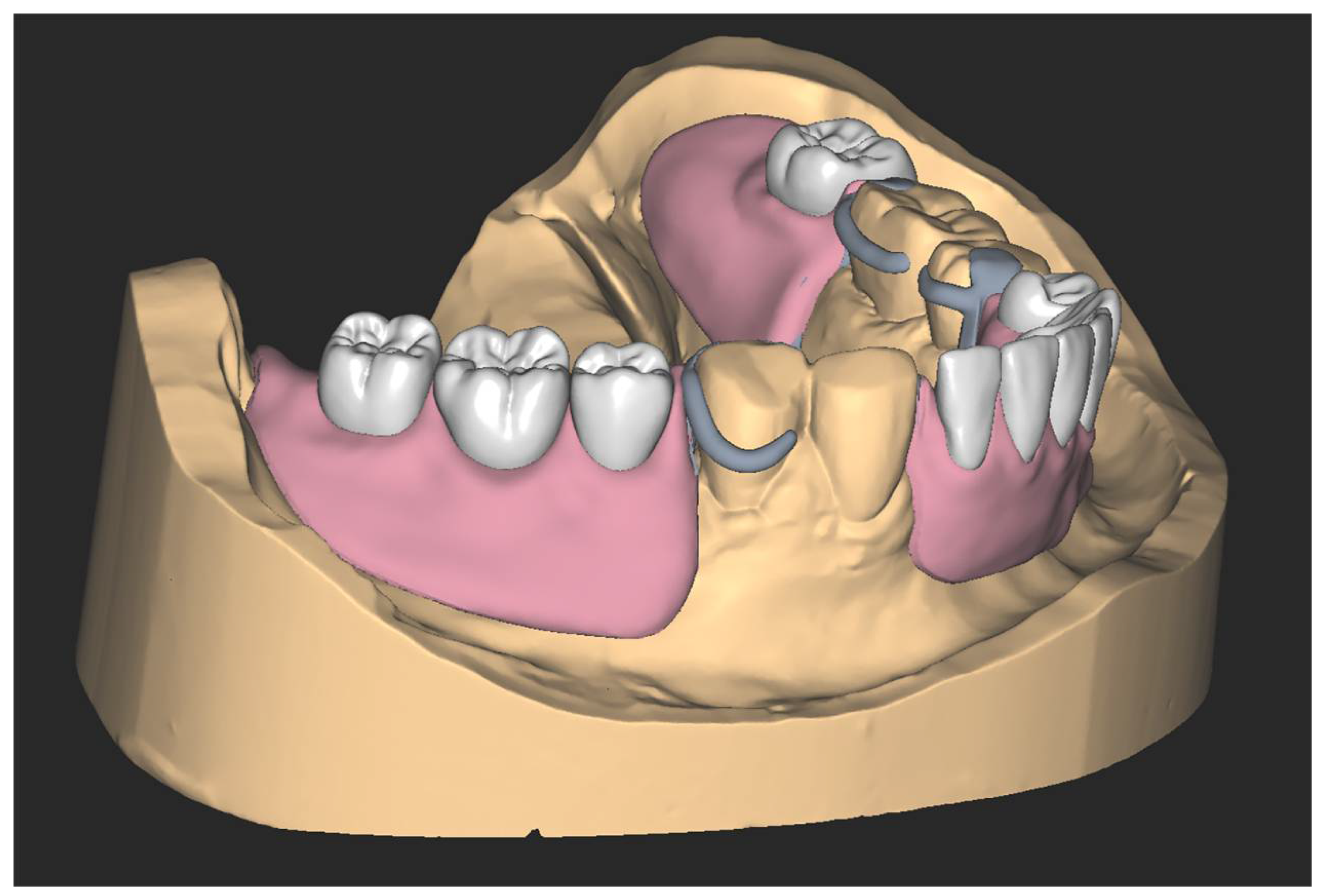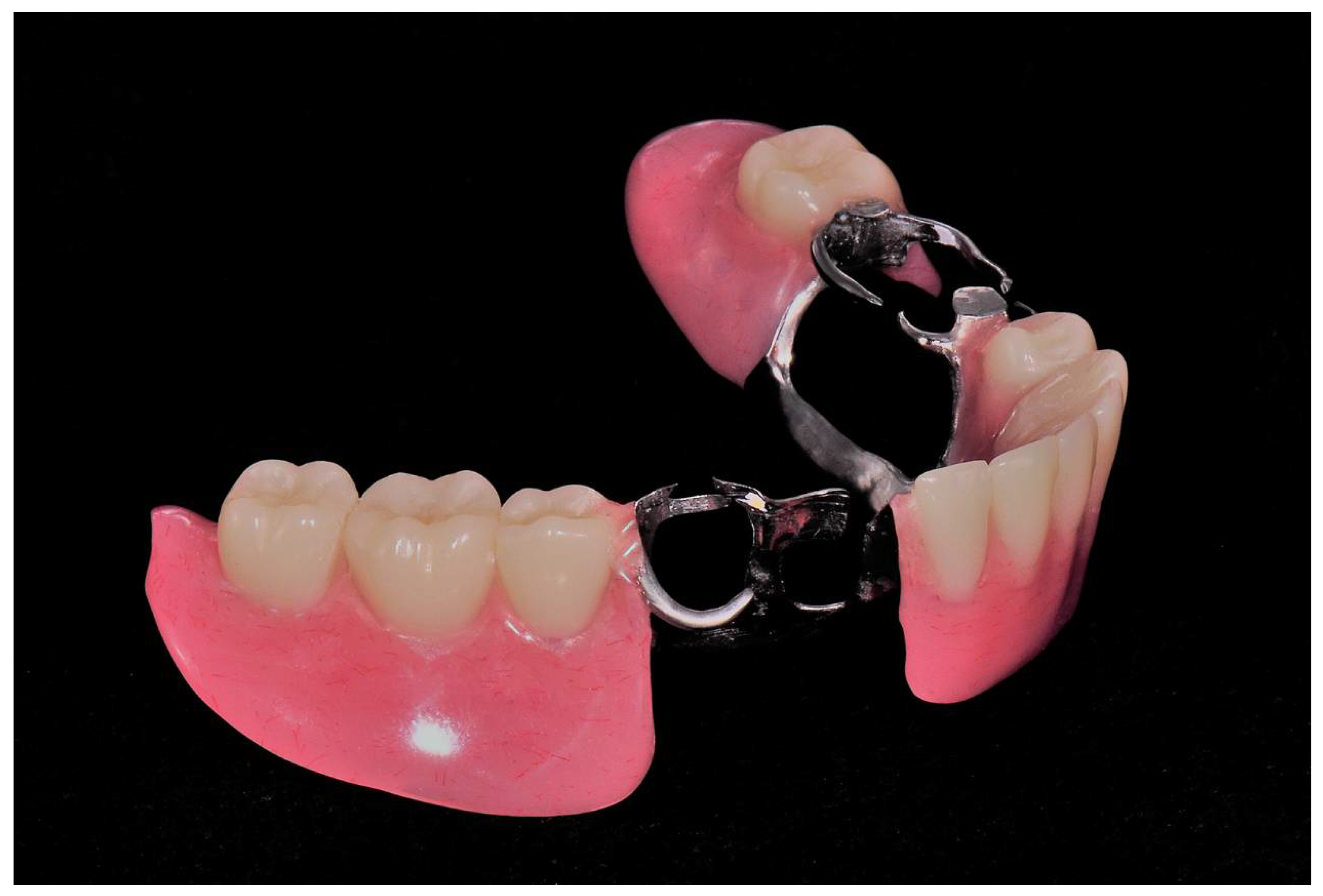A Digital Workflow for the Fabrication of a Milled Removable Partial Denture
Abstract
:1. Introduction
2. Materials and Methods
- Scan the master casts using a lab scanner (T500; Medit, Seoul, Korea) with a 7 µm scan accuracy (ISO 12836) and scan interocclusal relationship with the registered bite material. Export the data as the standard tessellation language (STL) format.
- Design the metal framework with a dental CAD software program (exocad DentalCAD; exocad GmbH, Darmstadt, Germany) after importing the casts’ data.
- Fabricate the metal framework via the lost-wax casting technique after milling a wax disk (Mazic Wax; VERICOM Co., Ltd., Chuncheon, Korea).
- Check the fit of the metal framework in the patient’s mouth and record the centric relation.
- Scan the centric relation record and assemble the digitized master casts accordingly.
- Design the denture base with teeth sockets and artificial teeth with a customized occlusal surface assembly with the CAD software program (exocad DentalCAD; exocad GmbH, Darmstadt, Germany). Export all data under the relative position to transfer numerical control data into the milling machine (Figure 1).
- Import the mandibular cast and RPD components data into a 3D modeling software program (Meshmixer; Autodesk Inc., San Rafael, CA, USA).
- Acquire the modified cast data with space for a base resin by selecting the region wider than the edentulous regions and intruding to 10 mm along the Y-axis with the aid of the “Extrude” function (Figure 2).
- Mill the artificial teeth from a disk-type double cross-linked resin block (SR Vivodent CAD; Ivoclar Vivadent AG, Schaan, Liechtenstein). Mill the modified mandibular cast from the metal jig in which gypsum material was poured and set. The metal jig was attached to the milling unit (Rainbow Mill-Zr 2nd; Dentium Co., Ltd., Seoul, Korea).
- Seat the metal framework on the milled stone cast and pour autopolymerizing resin (Retec PRESS LT; Retec Kunststofftechnik GmbH, Rosbach, Germany) to fill the metal jig (Figure 4). Polymerize the resin with a pressure polymerization unit ((Palamat elite; Kulzer GmbH, Hanau, Germany) following the manual.
- Mill the denture base and offset metal structure complex after calculating the toolpath on a CAM software (hyperDent V8.2; FOLLOW ME! Technology GmbH, Munich, Germany) (Figure 5).
- Complete the RPD by removing offset resin and gypsum from the framework, bonding the milled teeth to the teeth sockets and polishing the prosthesis (Figure 6).
3. Discussion
4. Conclusions
Author Contributions
Funding
Institutional Review Board Statement
Informed Consent Statement
Data Availability Statement
Conflicts of Interest
References
- Al-Haj Husain, N.; Ozcan, M.; Schimmel, M.; Abou-Ayash, S. A digital cast-free clinical workflow for oral rehabilitation with removable partial dentures: A dental technique. J. Prosthet. Dent. 2020, 123, 680–685. [Google Scholar] [CrossRef] [PubMed]
- Piao, X.; Park, J.M.; Kim, D.H.; Shim, J.S. Application of additive and subtractive manufacturing technology for a digitally fabricated removable partial denture after a partial maxillectomy: A clinical report. J. Prosthet. Dent. 2022, 127, 184–188. [Google Scholar] [CrossRef] [PubMed]
- Bohnenkamp, D.M. Removable partial dentures: Clinical concepts. Dent. Clin. N. Am. 2014, 58, 69–89. [Google Scholar] [CrossRef] [PubMed]
- Goodacre, C.J.; Garbacea, A.; Naylor, W.P.; Daher, T.; Marchack, C.B.; Lowry, J. CAD/CAM fabricated complete dentures: Concepts and clinical methods of obtaining required morphological data. J. Prosthet. Dent. 2012, 107, 34–46. [Google Scholar] [CrossRef]
- Kanazawa, M.; Inokoshi, M.; Minakuchi, S.; Ohbayashi, N. Trial of a CAD/CAM system for fabricating complete dentures. Dent. Mater. J. 2011, 30, 93–96. [Google Scholar] [CrossRef] [PubMed] [Green Version]
- Inokoshi, M.; Kanazawa, M.; Minakuchi, S. Evaluation of a complete denture trial method applying rapid prototyping. Dent. Mater. J. 2012, 31, 40–46. [Google Scholar] [CrossRef] [PubMed] [Green Version]
- Wang, C.; Shi, Y.F.; Xie, P.J.; Wu, J.H. Accuracy of digital complete dentures: A systematic review of in vitro studies. J. Prosthet. Dent. 2021, 125, 249–256. [Google Scholar] [CrossRef] [PubMed]
- Saponaro, P.C.; Yilmaz, B.; Johnston, W.; Heshmati, R.H.; McGlumphy, E.A. Evaluation of patient experience and satisfaction with CAD-CAM-fabricated complete dentures: A retrospective survey study. J. Prosthet. Dent. 2016, 116, 524–528. [Google Scholar] [CrossRef] [PubMed]
- Arnold, C.; Hey, J.; Schweyen, R.; Setz, J.M. Accuracy of CAD-CAM-fabricated removable partial dentures. J. Prosthet. Dent. 2018, 119, 586–592. [Google Scholar] [CrossRef]
- Tregerman, I.; Renne, W.; Kelly, A.; Wilson, D. Evaluation of removable partial denture frameworks fabricated using 3 different techniques. J. Prosthet. Dent. 2019, 122, 390–395. [Google Scholar] [CrossRef] [PubMed]
- Oh, K.C.; Jeon, J.; Kim, J.H. Fabrication of a removable partial denture combining conventional and digital techniques. J. Prosthet. Dent. 2021, 125, 588–591. [Google Scholar] [CrossRef]
- Oh, K.C.; Jeon, J.; Kim, J.H. Top-down design and fabrication with digital technology of removable partial dentures incorporating custom abutments: A dental technique. J. Prosthet. Dent. 2022. [Google Scholar] [CrossRef] [PubMed]
- Nishiyama, H.; Taniguchi, A.; Tanaka, S.; Baba, K. Novel fully digital workflow for removable partial denture fabrication. J. Prosthodont. Res. 2020, 64, 98–103. [Google Scholar] [CrossRef] [PubMed]
- Piao, X.-Y.; Shim, J.-S.; Park, J.-M. Fabrication of Metal-Reinforced Complete Dentures Using the CAD-CAM Technique. Appl. Sci. 2021, 11, 7369. [Google Scholar] [CrossRef]
- Schimmel, M.; Akino, N.; Srinivasan, M.; Wittneben, J.G.; Yilmaz, B.; Abou-Ayash, S. Accuracy of intraoral scanning in completely and partially edentulous maxillary and mandibular jaws: An in vitro analysis. Clin. Oral Investig. 2021, 25, 1839–1847. [Google Scholar] [CrossRef] [PubMed]
- Lo Russo, L.; Lo Muzio, E.; Troiano, G.; Guida, L. Cast-free fabrication of a digital removable partial denture with a polyetheretherketone framework. J. Prosthet. Dent. 2021. [Google Scholar] [CrossRef] [PubMed]






Publisher’s Note: MDPI stays neutral with regard to jurisdictional claims in published maps and institutional affiliations. |
© 2022 by the authors. Licensee MDPI, Basel, Switzerland. This article is an open access article distributed under the terms and conditions of the Creative Commons Attribution (CC BY) license (https://creativecommons.org/licenses/by/4.0/).
Share and Cite
Piao, X.-Y.; Jeon, J.; Shim, J.-S.; Park, J.-M. A Digital Workflow for the Fabrication of a Milled Removable Partial Denture. Int. J. Environ. Res. Public Health 2022, 19, 8540. https://doi.org/10.3390/ijerph19148540
Piao X-Y, Jeon J, Shim J-S, Park J-M. A Digital Workflow for the Fabrication of a Milled Removable Partial Denture. International Journal of Environmental Research and Public Health. 2022; 19(14):8540. https://doi.org/10.3390/ijerph19148540
Chicago/Turabian StylePiao, Xing-Yu, Jeongho Jeon, June-Sung Shim, and Ji-Man Park. 2022. "A Digital Workflow for the Fabrication of a Milled Removable Partial Denture" International Journal of Environmental Research and Public Health 19, no. 14: 8540. https://doi.org/10.3390/ijerph19148540






